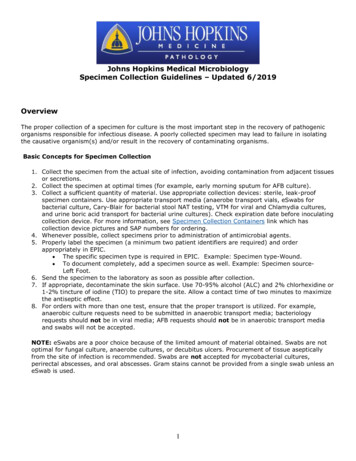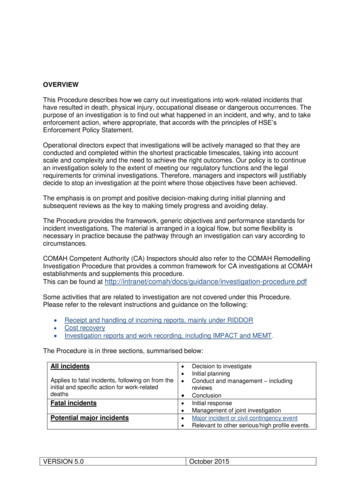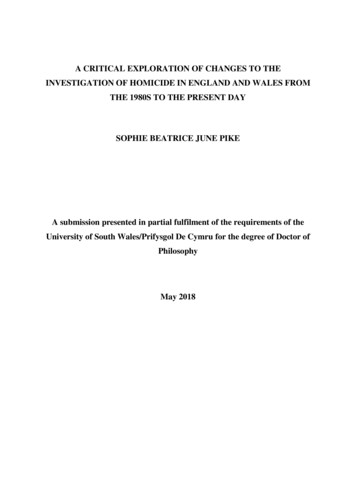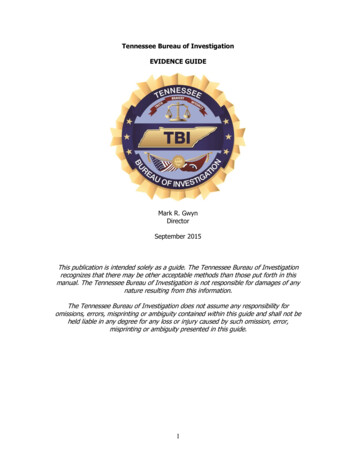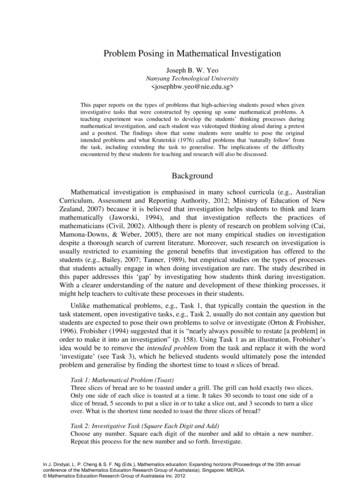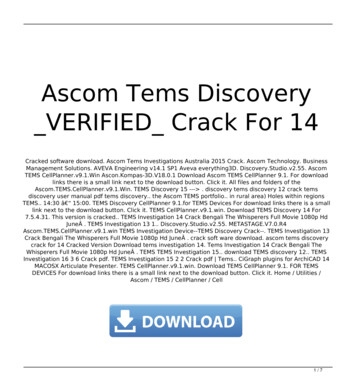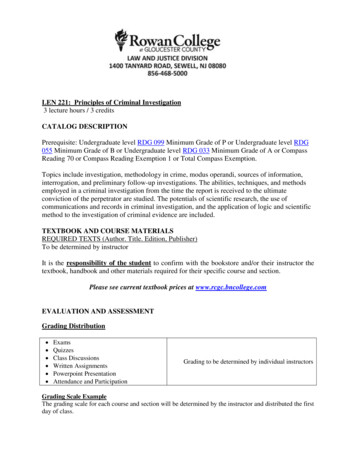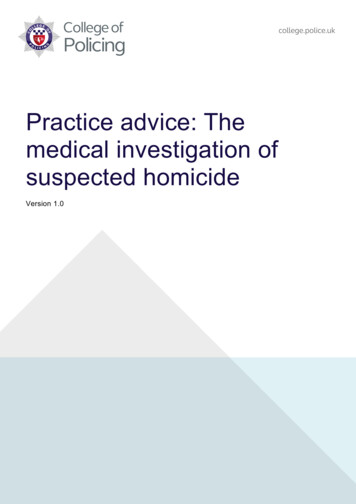
Transcription
Practice advice: Themedical investigation ofsuspected homicideVersion 1.0
Practice advice: The medical investigation of suspected homicideCollege of Policing LimitedLeamington RoadRyton-on-DunsmoreCoventry CV8 3EN – College of Policing Limited (2019)All rights reserved. No part of this publication may be reproduced, modified, amended,stored in any retrieval system or transmitted, in any form or by any means, without the priorwritten permission of the College or as expressly permitted by law.Anyone wishing to copy or reuse all or part of this publication for purposes other thanexpressly permitted by law will need a licence. Licence applications can be sent to theCollege’s Intellectual Property Rights (IPR) and Licensing Manager atdiane.kennedy@college.pnn.police.ukWhere we have identified any third party copyright material you will need permission fromthe copyright holders concerned. This publication may contain public sector informationlicensed under the Open Government Licence v3.0 licence/version/3/For any other enquiries regarding this publication, please emailjo.taylor@college.pnn.police.ukFor suggestions regarding amendments and updates, please emailpathology@homeoffice.gov.ukThis document has been created with the intention of making the content accessible to thewidest range of people regardless of disability or impairment. To enquire about having thisdocument provided in an alternative format please email us police.ukPage 2 of 57Version 1.0
Practice advice: The medical investigation of suspected homicideContentsIntroduction . 6Dealing with death . 6Death investigation . 8The pathology strategy. 9Strategy content. 9Key roles. 10Home Office registered forensic pathologist . 10Coroner’s officer . 13Other expertise available . 13Initial response and actions to be taken before postmortem . 16Reporting to the coroner . 16Initial SIO actions . 16Crime scene attendance . 17Briefing the forensic pathologist . 17Taking samples. 19Lawful seizure at the scene . 19Samples . 19Removal of the body . 20Victim identification . 22Visual identification . 22Primary methods. 22Secondary methods . 22Assistance only methods . 23Databases . 23Mass fatalities . 24Bodies washed up on beaches . 24Forensic anthropology . 24Family liaison . 25Version 1.0Page 3 of 57
Practice advice: The medical investigation of suspected homicideTime and cause of death . 26The postmortem examination . 28Religious and other considerations . 28Attendance at postmortem examinations . 28Health and safety . 30Lawful seizure at a postmortem . 30Samples . 31Recording retained material . 32Recording the postmortem examination . 32Exhibits . 34The postmortem examination report . 35Initial findings . 35Content of the report . 35Production of the report . 36Rapid interim accounts . 37Delays . 37Interpreting postmortem examination results . 38The role of the forensic pathologist . 38Issues for consideration . 38Defence and second postmortem examinations . 41Second postmortem examinations . 41Use of a non-forensic pathologist . 41Attendance at a second postmortem examination. 42Samples . 42Postmortem examination report . 42Release of the body . 44Release of the body . 44Likelihood of imminent arrest . 44Religious and other considerations . 45Communication with the family . 45Page 4 of 57Version 1.0
Practice advice: The medical investigation of suspected homicideRetention of material after postmortem examination . 46Continuity. 46Notification of preservation of material . 46Human Tissue Act . 46Criminal Procedure and Investigations Act. 47Human Tissue Audit . 47Disposal of material held on the authority of the police . 49Disposal of human tissue no longer required for a criminal justice purpose . 50Category 1 . 51Category 2 . 52Category 3 . 53Sensitive disposal . 54Incineration . 54Cremation . 54Further reading . 56Legal. 56Police . 56Medical . 56Contributors . 57Version 1.0Page 5 of 57
Practice advice: The medical investigation of suspected homicideIntroductionThis guidance provides advice on dealing with the pathology aspects of an investigation intoa sudden and unexplained death. Separate guidance provides advice on the initial actionsbefore instigating a homicide investigation (see Death investigation).Together, they replace Chapter 11 (Pathology) of the ACPO (2006) Murder InvestigationManual and have been approved by NPCC, the Chief Coroner and the Coroners’ Society ofEngland and Wales.This advice relates to the investigation of the death of adults. Separate practice advice canbe found for the investigation into the death of children at the following ling with deathDealing with the death of a human being is one of the most fundamental roles withinpolicing, and one that has, over the years, brought much criticism to the police service inEngland and Wales.The system of death investigation in England and Wales essentially fits into one of threepathways: Death which is anticipated due to ill health and where a medical doctor is able to issue aMedical Certificate of the Cause of Death (MCCD). Death where a doctor is unable to issue a certificate because they had not recently beentreating the deceased or the death was unexpected. The case is then referred to acoroner for investigation. This will usually involve the police and/or the coroner’s officerattending the scene of the death and completing an initial investigation on behalf of thecoroner. If the outcome of that investigation is that the death is not suspicious, and thereis no third party involvement, the coroner will continue with the investigation. This is oftenassisted by the police, which may involve the appointment of a non-forensic hospital‘histopathologist’ to conduct a postmortem examination to help determine the medicalcause of death. Death where the outcome of the police investigation is that the case is suspicious, thepolice take on primacy in the investigation. In consultation with the police, the coronerwill appoint a Home Office registered forensic pathologist (HORFP) to conduct thePage 6 of 57Version 1.0
Practice advice: The medical investigation of suspected homicidepostmortem examination. The two disciplines of normal non-forensic postmortems andforensic postmortems are very different. Therefore, if the outcome of that initial policeinvestigation is flawed, and the decision by the police is that the case is not suspicious,there will be no forensic examination of the body and a potential homicide could bemissed.Forensic pathology in England and Wales is overseen by the Home Office PathologyDelivery Board (PDB), which is responsible for the maintenance of the Home Office Registerof Forensic Pathologists and issues connected with the medical investigation of death inpolice cases.A report published by the Forensic Science Regulator in December 2015 1 highlights thepotential to ‘miss’ a homicide. In order to reduce the likelihood of such a miss, it is essentialthat the police service deals with death in a systematic and professional manner.Forensic pathology is an essential element in most suspicious death and homicideinvestigations. Senior investigating officers (SIOs) must have a clear knowledge of howpathology can assist an investigation, and of the various issues that are associated with thediscipline.HORFPs are appointed in each suspicious death case by the senior coroner for the relevantdistrict, and in consultation with the local chief officer of police. In such cases, the forensicpathologist receives a statutory fee from the coroner in accordance with the CoronersAllowances, Fees and Expenses Regulations 2013. 2 The police also pay the forensicpathologist a case fee as an expert witness.A Study into Decision Making at the Initial Scene of Unexpected /uploads/attachment data/file/484298/Report intothe 2012 FSR FP Audit Publication copy pdf2 The Coroners Allowances, Fees and Expenses Regulations schedule/made1Version 1.0Page 7 of 57
Practice advice: The medical investigation of suspected homicideDeath investigationThe following diagram outlines the process of death investigation in England and Wales. Itincludes the boundaries between this guidance and the ‘Dealing with sudden andunexpected death’ guidance.Page 8 of 57Version 1.0
Practice advice: The medical investigation of suspected homicideThe pathology strategyStrategy contentThere are several issues that must be addressed in relation to pathology: Notifying the coroner, who will appoint a forensic pathologist to undertake thepostmortem examination in consultation with the police. 3 Consideration of health and safety and staff welfare arrangements. Assessing the value of a forensic pathologist’s attendance at the crime scene or accessby remote visual means. Liaising with the forensic pathologist throughout the investigation. Removal of the body, including: owhat actions must be performed before its removalosupervising the removalocontinuity of the body from the scene to the mortuaryoidentifying the body to the forensic pathologist, prior to the postmortem examination(or establishment of continuity if identity is unknown).Deciding who should attend the postmortem examination and/or scene, includingspecialists. Providing the correct resources at the postmortem examination to deal with exhibits,samples and photography. Forensic postmortem examinations must take place in a mortuary which is licensed bythe Human Tissue Authority (HTA).4 This includes temporary mortuaries. The mortuarymust be suitably equipped for conducting forensic postmortem cases. The ForensicScience Regulator is in the process of developing standards for mortuary facilities inEngland, Wales and Northern Ireland, which will appear in future updated versions of thisAPP when published. Family liaison considerations presented by the postmortem examination.The Coroners (Investigations) Regulations 2013 Part 3, Regulation gulation/12/made4 Human Tissue Act 2004. ts3Version 1.0Page 9 of 57
Practice advice: The medical investigation of suspected homicide Potential for an additional examination of the body or relevant material, ie the second or‘defence postmortem examination’. Consideration of the legal issues that may arise during the forensic medical examinationof a foetus. A foetus which is born alive becomes a living person, independent from itsmother. Where the foetus does not survive until birth or is stillborn, it has not lived and asa result, has not died. This means that the coroner (in England and Wales) has nojurisdiction over a foetus or stillborn child. It also means that any medical or scientificexamination of the remains does not amount to a postmortem examination. If an officialpostmortem examination is granted, then any examination should be carried out in thesame circumstances and to the same standards as would apply to a deceased infant.The police powers to seize and examine, or order the examination of evidence, can beapplied to a foetus or stillborn child. The position in Northern Ireland is different, wherethe coroner has jurisdiction. Release of the body. Issues surrounding seizure and retention of human tissue (see Retention of materialafter postmortem examination). Additional considerations in relation to child death investigations (see the ACPO Guide toInvestigating Child Deaths 5).These issues and any additional elements of the forensic strategy must be logged in thepolicy file and continuously reviewed.Key rolesPathology plays an essential role in forming the forensic strategy. The followingprofessionals are key to this process.Home Office registered forensic pathologistHome Office registered forensic pathologists (HORFPs) (England and Wales)/consultantforensic pathologists (Scotland)/state pathologists (Northern Ireland), plus paediatric andother organ specific pathology specialists (such as neuro eye and bone pathologists) assistthe forensic pathologists in their investigations. The SIO may draw on the expert assistanceof a forensic pathologist on a number of areas, including:5 ACPO (2014) A Guide to Investigating Child age 10 of 57Version 1.0
Practice advice: The medical investigation of suspected homicide Advising on the removal of the body to the mortuary. Assisting with the identification of the victim. Assessing the size, physique and previous health of the victim. Determining the cause, mode and potential time of death where possible. Obtaining and recording evidence, including advising on detailed photographic evidenceof external and internal injuries. Providing advice on the possible type and dimensions of any weapon. Setting the postmortem examination findings in context with the initial crime sceneassessment. Assisting the SIO with early lines of enquiry. Contributing to the forensic strategy. Contributing to the decision-making process throughout the inquiry, as appropriate. Advising on the use of cross-sectional imaging of the body prior to the postmortem.Strategies relating to crime scene management and the collection and analysis of forensicevidence are inextricable from pathology. The SIO will need to take account of all of thelatter points when developing, reviewing and managing the forensic strategy.Forensic pathologists are on call 24 hours a day, 7 days a week to respond to requests toattend scenes, and conduct postmortem examinations in accordance with local force MoU,or contractual agreements and the Code of Practice and Performance Standards forForensic Pathology in England, Wales and Northern Ireland. 6 They can advise on health andsafety issues in conjunction with the crime scene manager (CSM) at the scene and withinthe postmortem examination room or mortuary. It is established good practice that forensicpathologists conduct postmortem examinations in all suspicious death cases. If a nonforensic pathologist conducts a postmortem examination of a suspicious death, they areexpected to comply with the same performance standards.Code of practice and performance standards for forensic pathology in England, Wales and NorthernIreland. ds/attachment df6Version 1.0Page 11 of 57
Practice advice: The medical investigation of suspected homicideIn common law, physical control over the body rests with the coroner, and after consultationwith the chief officer of police 7, the coroner should appoint a ‘suitable practitioner’ (a forensicpathologist) (Regulation 11) to conduct a postmortem examination as soon as reasonablypossible in cases where a homicide is suspected.Where the police have notified the coroner (Regulation 12) that a homicide offence issuspected in connection with the death, the coroner must notify the police of the date, timeand place at which the postmortem examination is to be made, and a police representativemay attend the postmortem examination.The police are also entitled to be represented at the postmortem examination by a medicalpractitioner. 8Using non-registered pathologistsUsing a non-forensic pathologist may lead to a homicide being missed, or could lead to theloss of vital forensic trace or DNA evidence transferred to the deceased from the offender. 9Maintaining contact with the forensic pathologistThe role of the forensic pathologist is not limited to the postmortem examination. There maybe regular contact between the investigation team and the forensic pathologist throughoutthe investigation, including certain decision-making points with the Crown ProsecutionService (CPS). This is often the case when evidence relevant to the injuries or cause ofdeath becomes available from witnesses, scientists or the offender as the investigationprogresses.It is essential there is effective and documented communication between the SIO, coronerand forensic pathologist. As soon as the case has been referred to the CPS, details of theCPS lawyer should also be provided to the coroner.Photographs of the scene and relevant scientific results from a postmortem examinationsuch as toxicology results must be relayed to the forensic pathologist as soon as possible,along with any other issues relating to the injuries or cause of death that become apparentduring the investigation.The Coroners (Investigations) Regulations 2013, Regulation gulation/12/made8 The Coroners (Investigations) Regulations 2013, Regulation 13 (3) and 13 (3) egulation/13/made9 ACPO Journal of Homicide and Major Incident Investigation Volume 9, Issue 2 Nov 2014 (page 58).http://library.college.police.uk/docs/J Homicide MII/J Homicide 9.2.pdf7Page 12 of 57Version 1.0
Practice advice: The medical investigation of suspected homicideCoroner’s officerIt is essential that the enquiry team establish early liaison with the coroner through thecoroner’s officer, in order to get the necessary authority to conduct the postmortemexamination and have a forensic pathologist appointed.A designated coroner’s officer, who works directly for the coroner only, should beresponsible for producing the necessary file relating to identification, which will allow thecoroner’s investigation to be conducted. This ensures that action is taken to satisfy thecoroner that all examinations are completed before the body can be released. The SIO willliaise with the coroner to facilitate the release of the body when no further examination isrequired by the prosecution and defence.Other expertise availableOther medical expertiseIf the circumstances of the case require additional expertise to support the pathologicalexamination, such as a paediatric or organ specific pathologist (such as a neuropathologist),it is the responsibility of the forensic pathologist to make appropriate recommendations tothe SIO, crime scene manager and coroner.InjuriesIn addition to medical experts, the SIO may also (in consultation with the forensicpathologist) consider contacting the National Crime Agency (NCA) Major Crime InvestigativeSupport team’s National Injuries Database (NID) for advice and guidance (0845 000 5463,mcis@nca.pnn.police.uk).In all cases where additional experts are used for pathology related investigations, theoriginal forensic pathologist should be consulted and all necessary steps must be taken toensure continuity. The forensic pathologist is responsible, in consultation with the coronerand the SIO, for advising on the need for additional examinations and/or investigations.Radiological examinations and body scanningWhile it is appreciated that scanning facilities may not be universally available, the use ofradiological examination and/or CT and MRI scans must be considered in consultation withthe forensic pathologist in: cases of suspected non-accidental injury in childrenVersion 1.0Page 13 of 57
Practice advice: The medical investigation of suspected homicide all deaths involving firearms or explosives.It can also greatly assist in the examination of badly burnt or decomposed bodies and mayalso be appropriate in other instances, for example sharp wounds where knives haveimpacted on the bone.Skeletal surveys are considered mandatory for the investigation of unexplained child deaths.Where available, MRI scans should be reserved for children.AdvantagesWhere facilities are available, scanning may assist an investigation for the following reasons: It captures external and internal features (within the limits of CT scanning) prior to anyinvasive procedures. This provides a permanent record that can be reviewed at any timein the future (so-called ‘virtual exhumation’) by properly interested persons. Thesefeatures can be later used for the presentation of pathology matters within a court settingwith the use of 2D and 3D images, as well as movies. It permits the documentation of the presence of external and internal injuries that can beidentified with CT. It may identify some pre-existing natural disease. This would include the identification ofinfectious diseases such as tuberculosis prior to opening a body. It may identify the location of foreign bodies on and inside the body. It can assist in identifying a potential cause of death and permit some postulation upon apotential mechanism of death. It can potentially be used to assist in the estimation of postmortem interval (time ofdeath), although the current evidence base for this is at a basic level, and should not berelied upon as sole evidence in this field of practice. It can assist in the identification of an individual. It can assist with the collection of biological samples by needle such as toxicology,microbiology and histology.LimitationsThe limitations of CT imaging are: It cannot be used to document the nature or location of bruises or abrasions on thesurface of the body. An external examination is needed instead. It will not be able to demonstrate the path of (for example) a stab wound or projectile tothe same level as an invasive examination.Page 14 of 57Version 1.0
Practice advice: The medical investigation of suspected homicide It can identify the location of a bruise in internal structures, although this is not currentlyat the same level as that of an examination by eye. While CT scanning may identify a potential cause of death, this may not be the actualcause of death.When contrast injection is used with CT, then toxicology, microbiology and other suchsamples should be taken prior to contrast injection. Contrast injection does not affectsubsequent DNA samples, including blood samples used for DNA identification.Other specialistsDepending on the nature of the death, the SIO should also consider (in consultation with theforensic pathologist, crime scene manager and coroner) inviting additional specialists toattend the postmortem examination. Examples of specialists who might be considered by theSIO include, but are not restricted to: Odontologist. Biologist. Botanist. Medical illustrator (decomposed bodies). Toxicologist. Ballistics expert. Entomologist. Anthropologist.
Practice advice: The medical investigation of suspected homicide . Page 6 of 57 Version 1.0 . Introduction . This guidance provides advice on dealing with the pathology aspects of an investigation into a sudden and unexplained death. Separate guidance provides advice on the initial actions before instigating a homicide investigation (see




